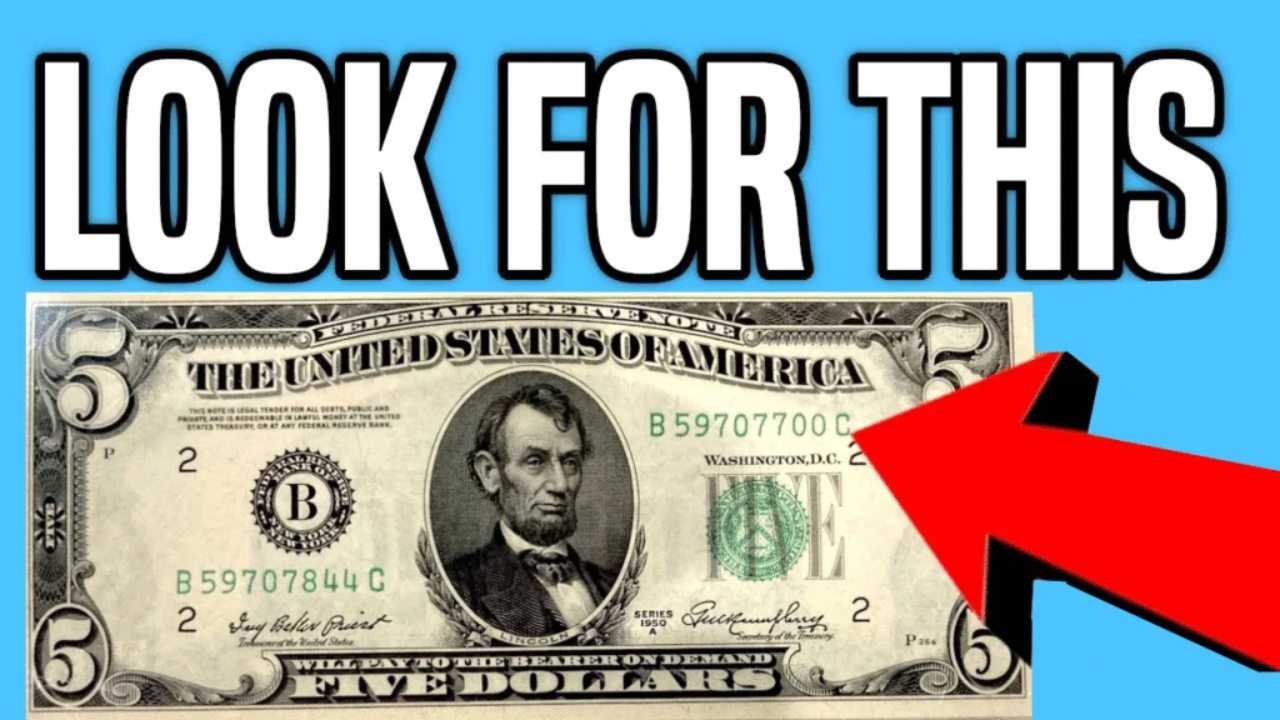Check the Money in Your Pocket: Have you ever looked closely at the cash in your wallet? Most people don’t, but a simple $5 bill from 1995 could be worth a lot more than five dollars if it has a special printing mistake. This mistake is called an upside-down seal error, where the green Treasury seal on the bill is flipped the wrong way. Collectors love these rare finds because they are unusual and hard to come by. In this article, we’ll explain what this error is, how to spot it, and what it might be worth. Who knows—you might have a hidden treasure right now!
What is the Upside-Down Seal Error?
The upside-down seal error is a type of mistake that happened when some $5 bills were made in 1995. Normally, the green seal from the U.S. Department of the Treasury sits upright on the right side of Abraham Lincoln’s picture. But on these rare bills, the seal is turned 180 degrees, making it look upside down. This makes the bill stand out to people who collect money, known as numismatists (that’s just a fancy word for currency collectors).
This error is super rare because the U.S. Bureau of Engraving and Printing—the place where money is made—has strict checks to catch mistakes. Only a small number of these flawed bills made it out into the world. Most known ones came from the Atlanta Federal Reserve Bank, which you can spot by an “F” in the seal on the left side.
How the Error Happened
Making paper money involves many steps, like printing the pictures, adding colors, and putting on security features. The Treasury seal is added near the end. In 1995, something went wrong—maybe a sheet of paper was fed into the machine the wrong way, or a printing plate was installed backward. This caused the seal to flip. Even though checks are in place, a few bills slipped through and ended up in people’s pockets.
How to Identify the Rare 1995 $5 Bill
Spotting this bill is easy if you know what to look for. You don’t need special tools—just good light and maybe a regular $5 bill to compare.
Step-by-Step Guide
- Check the Year: Look at the bottom right near Lincoln’s picture. It should say “Series 1995.” If it’s a different year, it’s not the one.
- Examine the Green Seal: Find the green Treasury seal on the right of Lincoln. On a normal bill, the scales (like a balance for weighing) are at the top, and the key is at the bottom, all facing up. On the error bill, everything is reversed—the scales are at the bottom, and it looks flipped.
- Look for Other Signs: Sometimes the serial numbers (the green numbers on the bill) might also be upside down. Check if the bill has standard safety features, like a watermark (a faint image of Lincoln when held to light) and a security thread (a strip that glows under UV light).
- Compare with a Normal Bill: Hold it next to a regular $5 bill. The difference in the seal should be clear.
Here’s a table to help you compare:
| Feature | Normal 1995 $5 Bill | Upside-Down Seal Error Bill |
|---|---|---|
| Treasury Seal Orientation | Upright, scales on top | Flipped 180 degrees, scales on bottom |
| Serial Numbers | Right-side up | May be upside down |
| Series Year | 1995 | 1995 |
| Federal Reserve Letter | Varies, but often F for Atlanta | Often F for Atlanta |
| Value | $5 | Hundreds to thousands |
The Value of the 1995 $5 Bill with Upside-Down Seal
The worth of this bill depends on how good it looks. Collectors pay more for bills in great shape. A worn-out one might sell for $200 to $500, while a fresh, uncirculated one (meaning it looks brand new, no folds or tears) could go for $1,000 to $5,000 or more at auctions. Some reports say top examples have sold for up to $20,000, but that’s rare and depends on the market.
Factors that affect value:
- Condition: Clean and crisp is best.
- Rarity: Fewer than 500 are thought to exist.
- Serial Numbers: Special patterns, like repeating digits or star notes (bills with a star in the serial number, used for replacements), add extra value.
Here’s a table showing estimated values based on condition:
| Condition | Description | Estimated Value |
|---|---|---|
| Poor/Circulated | Wrinkled, torn, used a lot | $200 – $500 |
| Good | Some wear, but intact | $500 – $1,000 |
| Very Fine | Light use, minor folds | $1,000 – $2,500 |
| Uncirculated | Like new, no wear | $2,500 – $5,000+ |
Always get it checked by experts to know the real worth.
What to Do If You Find One
If you think you have this rare bill, don’t spend it! Put it in a protective sleeve (a clear plastic holder) to keep it safe. Next, take it to a professional for checking. Groups like Paper Money Guaranty (PMG) or Professional Coin Grading Service (PCGS) can confirm if it’s real and grade its condition. Then, you can sell it at auctions like Heritage Auctions, on eBay, or to coin shops. Research recent sales to get a fair price.
FAQ
Q: Is the 1995 $5 bill with upside-down seal still legal money?
A: Yes, it’s real U.S. currency and can be spent, but you’d lose out on its collector value.
Q: How rare is this error?
A: Very rare—only a small batch escaped the printing checks.
Q: Can I find one in circulation today?
A: It’s possible, as old bills can still be around in wallets or change.
Q: What if my bill has an upside-down seal but looks fake?
A: Check security features. If doubtful, get it authenticated to avoid fakes.
Q: Are there similar errors on other bills?
A: Yes, but each is unique. The 1995 $5 is specific to that year and type.
Conclusion
Next time you get change or clean out your wallet, take a moment to check those old $5 bills. The 1995 version with an upside-down seal is a fun reminder that mistakes can create value. It’s not just money—it’s a piece of history that could turn into a nice payday. By knowing how to spot it, you might discover something special. Happy hunting, and remember to handle your cash with care!



